JANUARY 2019 ENEWS
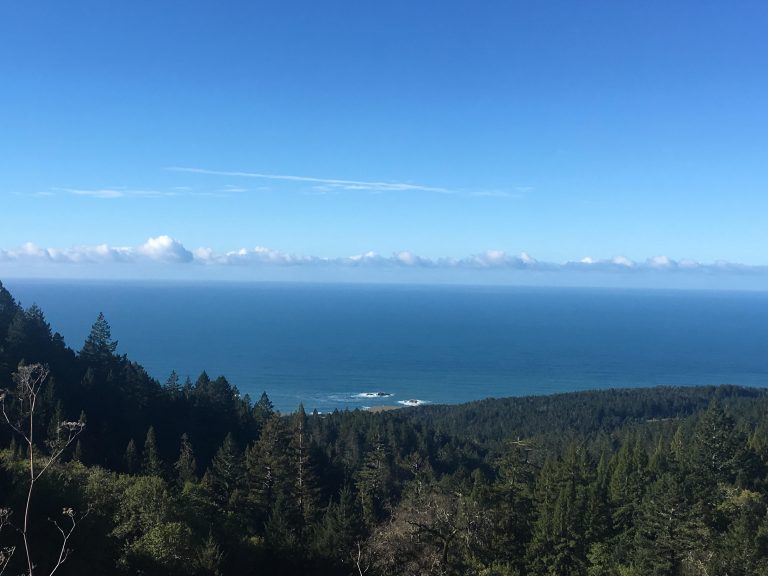
Dear Fort Ross and Salt Point friends,
New year, an abundance of green grass, and a fresh event calendar to inspire your next visit to the Sonoma Coast. Read all about it on the FRC calendar.
Up next is Alaska Native Day, acknowledging the many contributions of the Alaska Native community at Fort Ross. This year we’re fortunate to have the Anchorage Unangax Dancers sharing their traditional dancing from the Aleutian Islands of Alaska, Ekatherina Savvinova (Saina) of Sakha Republic performing her songs and sharing the Siberian Native history at the Fort, and Haida Artist Rachel Langford leading a metal etching project. And for the adventurous, join the 6th Annual John Sperry memorial Qayaq Race in Sandy Cove. Once again thanks go to Lauren Peters for organizing this event and bringing the Alaska Native community to Fort Ross.
The Fort Ross windmill is back in operation. Come watch this beast turn to the wind and learn about its unusual Russian construction during our interpretive talk and demonstration the first Saturday of every month (details on our Event Calendar).
The FRC team is bursting with enthusiasm and they’ve asked for more room to share their stories covering the natural, cultural and logistical wonders of our parks --everything from Gull Identification to volunteer opportunities. Master desktop publisher Sarjan changed the newsletter format to give them the space they need to write long and include more images. When you read “Click Here to Read The Full Article” you’ll jump to a web version of the newsletter. If you like what you’re reading or have questions, please let us know - we’d love to hear from you.
We did hear from many of you during our end-of-year fundraising drive, and for those of you who donated to Fort Ross Conservancy, thank you for your support! Every donation makes a difference to us and to the many people we serve. In 2018 we fundraised over $95,000 to provide underserved students access to our outdoor education programs - and that’s a 900% increase to our Fort Ross Education Fund from the prior year. Thanks for making that happen! And if you haven’t made a contribution, I hope you will consider joining FRC. We rely on our community to support us, and without that support we can’t steward the land nor inspire the next generation about the importance of that stewardship.
Speaking of our fantastic outdoor classroom: FRC offers educational opportunities for school groups, homeschoolers, and service groups such as boy and girl scouts. Our curricula serves elementary kids through college students, and our programming can run from a 90-minute educational walk-about to a meticulously planned overnight Environmental Living Program aligned to California teaching standards. Help us spread the word--we offer fee waivers to groups who need financial assistance! Learn more about our programs.
As 2019 starts to accelerate I hope you’re finding the time and space to be outdoors and appreciate the green grass and moving waters of our California winters. It’s a glorious time to get outside. See you soon at Fort Ross and Salt Point!
Warm regards,
Sarah Sweedler
Fort Ross Conservancy CEO
sarahs@fortross.org
Volunteer Opportunities in 2019
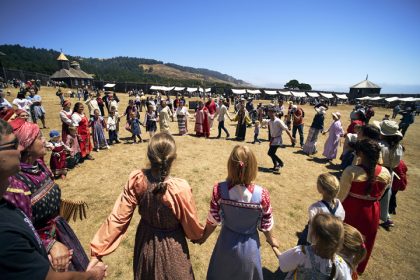
Are you looking for different ways to get out and explore your coastal public lands? Join us for one or all of the following volunteer opportunities this year:
- Marine Mammal Monitoring - monthly outings and surveys throughout the year
- Orchard Pruning - January through the end of March
- Viola Adunca (Western Dog Violet) Survey Training - beginning of March (date TBD)
- Viola Adunca Surveys - mid March through the end of June
- Salt Point Visitor Center docent - April to October
- Park Champions - May 19th
- Snapshot Cal Coast - June 8th
- Behren’s Silverspot Butterfly Survey Training - mid June (date TBD)
- Butterfly Surveys - mid June through the end of July
- Fort Ross Festival - July 27th
- Harvest Festival - October 12th
Our programs and events offer diverse options to explore the connections of history and nature that make our parks unique. All volunteer hours will contribute to the State Parks Volunteer In Parks program which awards volunteers with park passes depending on the number of hours served. Volunteers who complete 24 hours of service in a calendar year will receive a district-wide parks pass for the following year. A state-wide pass will be rewarded for 200 hours of service.
Please email melissab@fortross.org to participate, or if you have any questions!
Looking Backwards and Moving Forwards: Sea Lion Survey Annual Review
January is here! Can you believe it? Last year seemed to fly by and with it another year’s worth of sea lion surveys. As many of you know, with a devoted group of volunteers, we conduct monthly sea lion surveys of the Sea Lion Rocks at Fort Ross State Park. We have two resident species of sea lions living here in Fort Ross’ coastal waters: California (Zalophus californianus) and Steller sea lions (Eumetopias jubatus). During our surveys we collect information for a number of data points, including species population counts, sea lion behaviors, and any human-caused disturbances to the lions. Here’s an overview of why we conduct these surveys, some of the challenges we face during data collection, annual population trends, and how we’re looking to improve our monitoring methods in the new year.

Even though we collect data on both species of sea lions local to Fort Ross, our focus for these surveys originated with an interest in observing Steller sea lions. This sea lion species (which is the largest in the family Otariidae) was listed under the Endangered Species Act in 1990. Even though Stellers are protected under the Marine Mammal Protection Act (1972), this species of sea lion has been hit very hard over the last few decades and scientists are conducting much needed research to determine the exact causes of the devastating population declines. In 1997, NOAA Fisheries recognized two distinct population segments (dps) for Steller sea lions. There is a western dps and an eastern dps; our local Stellers are included in the latter. Scientists have found not only genetic and physical differences between the two distinct Steller populations but have also noticed that each dps is trending differently, so it made sense to track the populations separately. The western stock is still listed as endangered, whereas the eastern stock is considered to have recovered enough to be delisted. Being delisted is promising, but it doesn’t mean we shouldn’t continue to monitor the Stellers. Additionally it seems that most ongoing Steller research is being conducted on the endangered western dps, and we feel it’s important that we do what we can to keep an eye out for our local Stellers. And with Fort Ross being one of the few accessible places where the public can view Steller sea lions, we are in a unique position to be able to conduct these surveys.
The more surveys we conduct, the more we learn about our local sea lions but there is still much that we don’t know. We are a small operation and observe the offshore Sea Lion Rocks from a few strategic vantage points along the Park’s coastal blufftop -- or as our volunteer surveyors lovingly call it, “the edge of the world.” We only have visual access to the rockfaces that are viewable from land. By not having 360 degree visual access our counts are likely to be short of the true numbers of Stellers making use of these haulouts. Additionally, there a number of challenges in positively identifying each animal’s species (California or Steller). Some of these challenges include rough weather conditions, sun glare, and how an animal is positioned on the rock. There are a few different physical features to look out for to make an ID, but we have found the best way is to check for certain facial characteristics; when the animals are lying down flat and their heads aren’t clearly visible, identification becomes a lot more challenging. Our goal during data collection is to be as accurate as possible. We identify to the best of our ability but if we can’t make a positive ID we will count an animal as an “unidentified sea lion.”
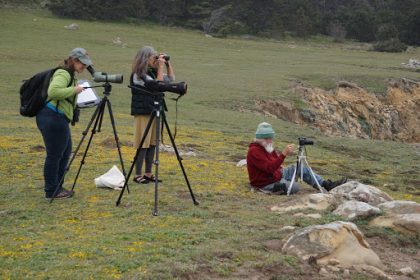
With these challenges, you start to get a sense that simply looking at the survey’s total Steller and total California counts is not sufficient to getting a full picture of our local population numbers. There are naturally a lot of factors to consider. However, we still are collecting a large body of precious data that would not exist without these surveys and the commitment of our volunteers. It’s also important to note that we’re continually striving to improve our methods and one of our new year’s resolutions is to get video recordings of the Sea Lion Rocks via a drone so we can get a better idea of how many sea lions are hanging out on the parts of these haulouts normally out of our view. Please note, using drones near the sea lions and other coastal wildlife is not something we will do lightly; we will do this in accordance with applicable regulations and be careful to not cause disturbances.
Here’s a summarized look of our survey data during 2018 :
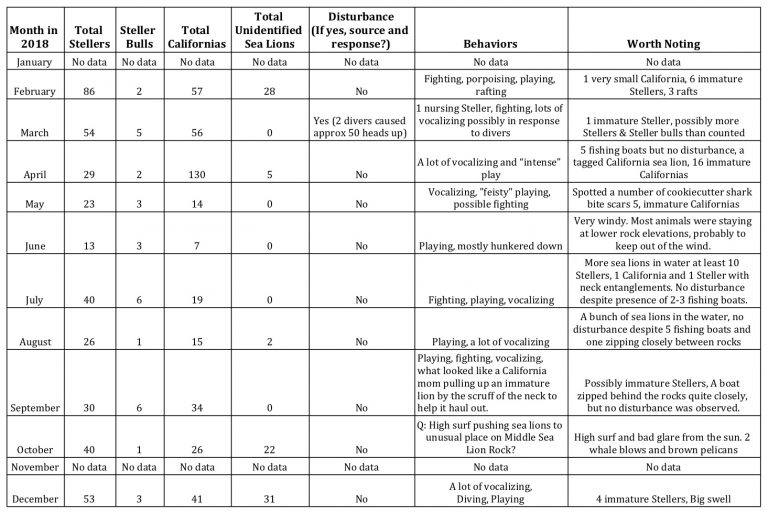
The most notable annual trend for us, although it’s not obvious from this table, is a drop-off in Steller numbers during the pupping season in the summer. We have eagerly kept a keen eye out, hoping to spot newborn Steller pups on our rocks, but so far we haven’t seen evidence of local pupping. This leads us to believe that the Stellers are going somewhere else to pup. We occasionally see immature Stellers nursing, but they are known to nurse for a long time, typically a year or two and sometimes even longer.
Another thing we notice in looking at the disturbance and behavior data is that we don’t often see our sea lions being disturbed by human activity. To get a really good sense of sea lion disturbance rates, we would need to do more frequent surveys during the times of the year when human use of our coastal waters is more intense. Since we’re only out there once a month we can’t assume that more disturbances aren’t occurring than our data suggests. This type of focused disturbance study is on our wishlist, but we don’t have the resources to take on an additional study at this time. We will continue to monitor and record disturbances during our monthly surveys, as well as looking out for any entanglements. As you’ll see in the table notes for July, we saw two neck entanglements which can obviously cause serious injury and even death. It was heartbreaking, but it helped to illustrate that our local sea lions are still facing threats and our continued monitoring is well worth the effort.
We’re excited for this coming year. We never know for sure what we’re going to see out there during our surveys, but we invariably come away feeling like it was time well spent. Not only a chance to continue gathering important information, but also to keep developing our relationships with these majestic mammals by deepening our understanding and, therefore, our appreciation of them: our pinniped friends at “the edge of the world.” Interested in joining in on the sea lion survey fun this year? Send me an email. Or if you are interested in supporting this and other Fort Ross Conservancy projects and initiatives please consider becoming a member.
Learn more about Steller seal lions from the Marine Mammal Center
NOAA Fisheries is a stellar source for Steller information!
We are grateful to the following organizations for their past support of this project:
Greater Farallones Association
Madrone Audubon Society
A special thanks to our sea lion survey volunteers:
Roberta Chan
Mary Pat Jacobs
Beth Kattleman
Dr. Joe Mortenson
Jane Straight
Until next time, wishing you a stellar New Year to you and our flippered friends!
--Charon Vilnai, Programs Instructor and Sea Lion Survey Project Lead
The Walls of Fortress Ross
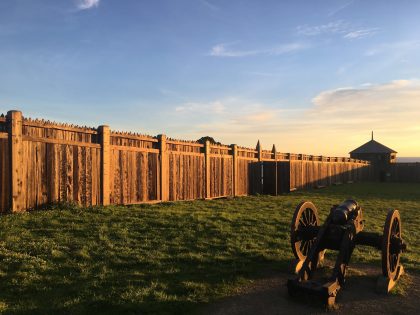 The original Fortress Ross (Крепость Росс) stockade walls were built by Russian American Company laborers in 1812, very soon after they arrived at Metini, the Kashia Pomo settlement. Built of redwood, the four walls are each approximately 1204 feet long (172 Russian sazhens) and 14 feet high (2 sazhens), held together by a complex system of mortised joints locked by wooden pins. The top truss and the sills were locked into main posts spaced about 12 feet apart extending about 6 feet into the ground.
The original Fortress Ross (Крепость Росс) stockade walls were built by Russian American Company laborers in 1812, very soon after they arrived at Metini, the Kashia Pomo settlement. Built of redwood, the four walls are each approximately 1204 feet long (172 Russian sazhens) and 14 feet high (2 sazhens), held together by a complex system of mortised joints locked by wooden pins. The top truss and the sills were locked into main posts spaced about 12 feet apart extending about 6 feet into the ground.
 During their thirty years at Settlement Ross, the Russian American Company leadership grew less concerned that they would be attacked. The Spanish, at the far reaches of their vast empire, didn’t have the resources to expel the Russians from what they considered their territory, and in fact the Spanish found trade with the Russian American Company advantageous (albeit not officially sanctioned). By 1817 the Russians had acquired from the Kashia Pomo the land immediately around Fortress Ross, and the Kashia and Russians signed an official protocol of agreement for the Russian settlement, which further weakened the Spanish claim to these lands. Also in 1817 the Kashia chief was given an “Allie of Russia” medallion which allowed him access inside the walls of the compound.
During their thirty years at Settlement Ross, the Russian American Company leadership grew less concerned that they would be attacked. The Spanish, at the far reaches of their vast empire, didn’t have the resources to expel the Russians from what they considered their territory, and in fact the Spanish found trade with the Russian American Company advantageous (albeit not officially sanctioned). By 1817 the Russians had acquired from the Kashia Pomo the land immediately around Fortress Ross, and the Kashia and Russians signed an official protocol of agreement for the Russian settlement, which further weakened the Spanish claim to these lands. Also in 1817 the Kashia chief was given an “Allie of Russia” medallion which allowed him access inside the walls of the compound.
As time when on, neighborhoods sprang up, near and far, outside the walls of the fort. The “sloboda” northwest of the fort (now between the Visitor Center and the Fort Compound) hosted the colony’s craftspeople and laborers, many from the growing Creole class. On the windy bluff in front of the fort the Alaska Native hunters (often with Native California wives) made their home. Far beyond the walls of Fortress Ross, after the Spanish missions had been decolonized and the Native Californian laborers set free, the Russians established three ranches to the south -- inland from Jenner; in Bodega; and between Occidental and Graton along Purrington Creek -- as a last gasp effort to make a go of their California experiment to rely on California to feed its Alaskan colonies.
Though the conditions for the Native Californians at Settlement Ross were far better than at the Spanish missions, relations between the varied ethnic groups and classes were far from perfect. The social fabric and traditions of the native inhabitants of Alaska and California were forever disrupted, with disease and injustices only now being fully recognized. Nevertheless, here at Settlement Ross it should be noted that despite the heavy fortification, Fort Ross cannons were never fired in battle.
Through the years the original stockade walls and sally ports deteriorated, and after Fort Ross became a State Park in 1906, sections of the walls were reconstructed between 1929 and recently in 2017. After Highway One was rerouted to bypass the Fort in 1972, the stockade was finally re-enclosed for the first time since the 1800s.


In recent years Russians, Kashaya Pomo, and Alaska Natives come together inside and outside the fort walls to celebrate and learn from their shared heritage and the unique Kashia, Alaska Native, Russian and Ranch Era cultures that co-existed on this common ground.
--Hank Birnbaum, Bilingual Guide, Historical Specialist & ELP Instructor
Gulls. Exciting You Say?
If you are anywhere on the birding spectrum, from novice to expert, living in or visiting Sonoma County is a birder’s delight. With so many habitats within a fairly short distance of one another, one can get very well acquainted with our local shore and seabirds, as well as inland songbirds and raptors.
One family of bird that is very often overlooked or outright disliked is the gull family (Laridae), but it is because of this family that I first caught the birding bug during my training as a NOAA Beach Watch volunteer.

To the untrained eye, all gulls may look the same, with a grey back, white body, hefty beak, and warm-toned legs. Once you start to delve into gull ID, a beautifully nuanced and diverse family of birds is unveiled.
With 27 species (and their hybrids) of gull in North America, learning your gulls could take a lifetime. They are the ultimate identification puzzle, testing one’s observation skills to their maximum. Imagine walking the bluffs of Fort Ross during our monthly survey and seeing a flock of 20 to 40 gulls headed your way. In just a matter of seconds, as they fly in front or above us, we must identify them all based on: the color of their mantle, mottling or striping on their head and neck, their leg color (IF we can see them), the size of the bird, how much black can be seen on the underside of their wingtips, eye color, color and markings on their beaks. And that doesn’t even begin to cover juveniles. Juvenile gulls of every species have wildly variable feather, beak and leg colors from year to year as well as from their adult plumage. It’s a thrilling challenge!
Most gull species are migratory, breeding during the summer in the northern range of their territory, then traveling south during the cold winter months. Others breed and winter in the same area, dispersing along the coast near their breeding sites.
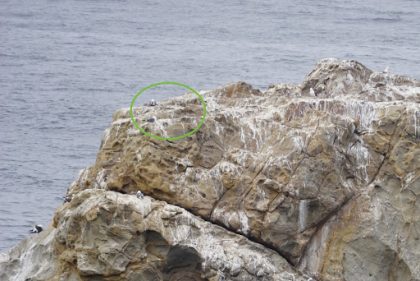
Gulls are monogamous birds, usually mating for life, but I have read that “divorces” can occur and, apparently, there are social repercussions for years after the breakup! It would seem we have some happily married couples of Western Gulls (Larus occidentalis) here at Fort Ross. During our survey on June 1, 2018, we were absolutely thrilled to spot six active nests on our Sea Lion Rocks. Then on July 2, we counted and photographed nine puffy grey chicks! Fort Ross is officially a Western Gull breeding site.
Throughout the year, the most common species of gull you’ll see at Fort Ross and along much of the California coast is the Western Gull, but we also get a sizable migration of California Gull in April and May, then again in December. In much fewer numbers we see Glaucous-winged, Heermann’s, Herring, and Mew Gulls.
See the graph below representing the migratory ebb and flow of our local gull species.
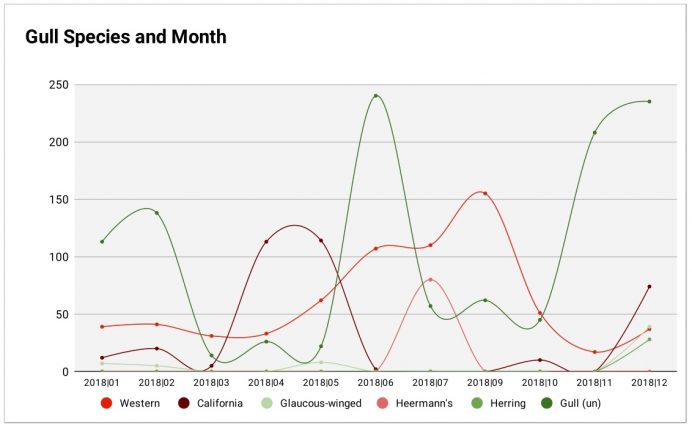
If this article has inspired or piqued your interest in learning your gull ID, here is an excellent Gull cheat sheet made by Alexander Brennen and the Greater Farallones Association Beach Watch team.
We are always curious to hear if other species are spotted in our area, and welcome guests during our monthly surveys. If you have any interest in joining us, please email me at Songh@fortross.org
To see the distribution of gull species along our coast, check out iNaturalist.
For a fun project, use this Gulls Hat knitting pattern from Ravelry.
--Song K. Hunter, Director of Programs